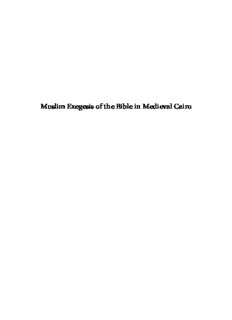
Muslim Exegesis of the Bible in Medieval Cairo: Najm al-Dīn al-Ṭūfī’s (d. 716/1316) Commentary on the Christian Scriptures. A Critical Edition and Annotated Translation with an Introduction PDF
Preview Muslim Exegesis of the Bible in Medieval Cairo: Najm al-Dīn al-Ṭūfī’s (d. 716/1316) Commentary on the Christian Scriptures. A Critical Edition and Annotated Translation with an Introduction
Muslim Exegesis of the Bible in Medieval Cairo History of Christian-Muslim Relations EditorialBoard DavidThomas,UniversityofBirmingham TarifKhalidi,AmericanUniversityofBeirut GabrielSaidReynolds,UniversityofNotreDame MarkSwanson,LutheranSchoolofTheologyatChicago VOLUME19 ChristiansandMuslimshavebeeninvolvedinexchangesovermattersoffaithandmorality sincethefoundingofIslam.Attitudesbetweenthefaithstodayaredeeplycolouredbythe legacyofpastencounters,andoftenpreservecenturies-oldnegativeviews. The History of Christian-Muslim Relations, Texts and Studies presents the surviving record of past encounters in authoritative, fully introduced text editions and annotated translations, and also monograph and collected studies. It illustrates the development inmutualperceptionsasthesearecontainedinsurvivingChristianandMuslimwritings, andmakesavailabletheargumentsandrhetoricalstrategiesthat,forgoodorforill,have lefttheirmarkonattitudestoday.Theseriescastslightonahistorymarkedbyintellectual creativityandoccasionalbreakthroughsincommunication,although,onthewholebesetby misunderstandingandmisrepresentation.Bymakingthishistorybetterknown,theseries seekstocontributetoimprovedrecognitionbetweenChristiansandMuslimsinthefuture. Thetitlespublishedinthisseriesarelistedatbrill.com/hcmr Muslim Exegesis of the Bible in Medieval Cairo Najm al-Dīn al-Ṭūfī’s (d. 716/1316) Commentary on the Christian Scriptures ACriticalEditionandAnnotated TranslationwithanIntroduction By LejlaDemiri LEIDEN•BOSTON 2013 Coverillustration:Köprülü,FazılAhmedPaşa795, frontpage(f.86a).CourtesyofSüleymaniye Library,Istanbul. ThispublicationhasbeenmadepossiblewithkindfundingfromtheIslamicManuscript Association(http://www.islamicmanuscript.org) LibraryofCongressCataloging-in-PublicationData Tufi,Sulaymanibn'Abdal-Qawi,1259?-1316. [Ta'liq'alāal-Anajilal-arba'ah.English&Arabic] MuslimexegesisoftheBibleinmedievalCairo:Najmal-Dinal-Tufi's(d.716/1316)commentary ontheChristianscriptures/acriticaleditionandannotatedtranslationwithanIntroductionby LejlaDemiri. p.cm.–(HistoryofChristian-Muslimrelations;v.19) Includesbibliographicalreferencesandindex. ISBN978-90-04-24316-3(hardback:alk.paper)–ISBN978-90-04-24320-0(e-book)1. Bible–Islamicinterpretations–Earlyworksto1800.2.Islam–Relations–Christianity.3.Christianity andotherreligions–Islam.I.Demiri,Lejla.II.Title. BP172.T864132013 220.7–dc23 2012041335 Thispublicationhasbeentypesetinthemultilingual“Brill”typeface.Withover5,100characters coveringLatin,IPA,Greek,andCyrillic,thistypefaceisespeciallysuitableforuseinthehumanities. Formoreinformation,pleaseseewww.brill.com/brill-typeface. ISSN1570-7350 ISBN978-90-04-24316-3(hardback) ISBN978-90-04-24320-0(e-book) Copyright2013byKoninklijkeBrillNV,Leiden,TheNetherlands. KoninklijkeBrillNVincorporatestheimprintsBrill,GlobalOriental,HoteiPublishing, IDCPublishersandMartinusNijhoffPublishers. Allrightsreserved.Nopartofthispublicationmaybereproduced,translated,storedin aretrievalsystem,ortransmittedinanyformorbyanymeans,electronic,mechanical, photocopying,recordingorotherwise,withoutpriorwrittenpermissionfromthepublisher. AuthorizationtophotocopyitemsforinternalorpersonaluseisgrantedbyKoninklijkeBrillNV providedthattheappropriatefeesarepaiddirectlytoTheCopyrightClearanceCenter, 222RosewoodDrive,Suite910,Danvers,MA01923,USA. Feesaresubjecttochange. Thisbookisprintedonacid-freepaper. Totheblessedmemoryofmylatefather ZulbeharDemiri (1943–2008) CONTENTS Preface.................................................................. ix Acknowledgements..................................................... xi Abbreviations........................................................... xiii ArabicTransliterationandDates ....................................... xv INTRODUCTION I Ṭūfī:LifeandWork................................................... 3 Biography............................................................ 3 Ṭūfī’sRelationshipwithShīʿīTradition .............................. 8 Ṭūfī’sApproachtoTaṣawwuf,KalāmandPhilosophy................ 15 Ṭūfī’sUnderstandingofMaṣlaḥa .................................... 21 Ṭūfī’sRoleinMuslim-ChristianRelations............................ 23 II Ṭūfī’sCriticalCommentaryontheBibleandItsContext ............ 29 TheInterreligiousMilieuoftheLate13thandEarly14thCenturies.. 29 Ṭūfī’sInterestinChristianityandChristianScriptures .............. 36 WhyDidṬūfīWriteHisCriticalCommentaryontheBible?......... 37 TheThematicStructureoftheTaʿlīq................................. 42 WhenDidṬūfīWritetheTaʿlīq? ..................................... 50 TheSignificanceoftheTitle,Taʿlīq................................... 51 Ṭūfī’sExegeticalMethod............................................. 52 TheArabicGospelsReadbyṬūfī..................................... 62 Conclusion ............................................................. 71 CRITICALEDITIONANDTRANSLATION NotesontheCriticalEdition,ManuscriptsandTranslation ............ 79 TheOriginalTextandItsTranslation................................... 90 Prologue ................................................................ 100 CriticalCommentaryontheGospelofMatthew ....................... 130 CriticalCommentaryontheGospelofMark ........................... 244 CriticalCommentaryontheGospelofLuke............................ 274 CriticalCommentaryontheGospelofJohn............................ 302 viii contents OntheAuthenticityoftheProphethoodofMuḥammad ............... 354 CriticalCommentaryontheBookofIsaiah ............................ 358 CriticalCommentaryontheBookofHosea ............................ 378 CriticalCommentaryontheProphecyofJonah ........................ 380 CriticalCommentaryontheProphecyofHabakkuk ................... 382 CriticalCommentaryontheBookofMalachi .......................... 398 CriticalCommentaryontheProphecyofJeremiah..................... 400 CriticalCommentaryontheBookofEzekiel ........................... 410 CriticalCommentaryontheBookofDaniel............................ 416 CriticalCommentaryontheBookofGenesis........................... 424 AppendixI:ListofṬūfī’sWorks......................................... 529 AppendixII:ListofBiblicalQuotationsandReferences................ 536 Bibliography ............................................................ 541 Index ................................................................... 559 PREFACE Itiswonderfultohaveanopenmind;itislikeopening upthewindowsofaroom.Itisgoodtohavethewin- dowsofaroomopen,butonlyprovided,ofcourse,the room has walls. If you take a couple of windows into themiddleofthedesert,itdoesnotmatterwhetheryou keepthemopenorclosedsincetherearenowalls. Anonymous1 MuslimsandChristianslivinginthemulti-religiousmilieuofthemedieval Muslimworldwereencircledbytheirown‘walls’and‘windows’.Religious loyaltyservedasaseparatingandunifyingfactor,simultaneouslyrevealing the differences they had and the similarities they shared. It was religion that distinguished them from one another, yet at the same time encour- agedthemtoexploreeachother’sfaithandtradition.Thescriptureofeach community of believers played a crucial role in this enterprise, providing essentialmaterialforself-identificationandawarenessaswellasinforming perceptionsofthe‘other’.Itcomesasnosurprisetoseethebirthoftheologi- calinteractionsfromtheverybeginningoftheMuslim-Christianencounter. On both sides, theologians were eager to defend their faith, as well as to expresstheirthoughtsandcritiquesofwhattheircounterpartsheldtobe true. TheQurʾanspeaksaboutthePeopleoftheBook(ahlal-kitāb),Jewsand Christians,theirfaithandpractices.ForaMuslim,therefore,exploringthe beliefandtraditionofthe‘other’ispromptednotonlybyintellectualcurios- ity and academic interest, but also by the aspiration to read and under- standwhatiswrittenintheBookofGod,theQurʾan.Encounterswithother faithcommunitiesledMuslimstoportrayandpresenttheteachingsoftheir religion in a more comprehensible manner to their Jewish and Christian counterparts.Thisundertakingaimedtoofferatheologicalexplanationfor theirownbeliefsandtorespondtothequestionsandobjectionsraisedby adherentsofotherfaithtraditions.Bothapologeticandpolemicalstrategies 1 ThispassageisquotedbyS.H.Nasrinhisarticle“InCommemorationofLouisMas- signon:Catholic,Scholar,IslamicistandMystic”,PresencedeLouisMassignon:Hommageset témoignages,Paris,1987,p.54. x preface shapedMusliminterestsinthestudyofotherfaiths,theresultingMuslim- Christiantheologicaldiscussions2takingforminvariousliterarygenres:as letter-exchanges between the two parties, fictional narratives of debates between‘themandus,’andforthemajorityofthetimeastheologicaltrea- tises.3 Najm al-Dīn Sulaymān al-Ṭūfī (d. 716/1316), a Ḥanbalī theologian origi- nallyfromIraq,isoneamongmanylearnedMuslimswhocontributedtothis tradition. His exegetical work, al-Taʿlīq ʿalā al-Anājīl al-arbaʿa wa-al-taʿlīq ʿalāal-Tawrāhwa-ʿalāghayrihāminkutubal-anbiyāʾ(CriticalCommentary ontheFourGospels,theTorahandotherBooksoftheProphets),however, standsoutfromtherestofthisliteratureduetoitsoriginalformat,structure andliterarystyle.TheTaʿlīqcontainsṬūfī’scriticalcommentsandannota- tionsontheBible.FromtheNewTestament,itcoversthefourGospels,while fromtheOldTestamentthefocusisonGenesis,Isaiah,Jeremiah,Ezekiel, Daniel, Hosea, Jonah, Habakkuk and Malachi. The present study makes Ṭūfī’sBiblicalcommentaryavailableforthefirsttime,offeringacriticaledi- tionoftheoriginaltext,itstranslationintoEnglishandadetailedanalysis of its contents. It further sheds light upon Ṭūfī’s role in Muslim-Christian theologicalinteractionsandhiscontributiontotheMuslimunderstanding ofChristiantheologyinearly14thcenturyEgypt.Inthestudyofthetext, acomparativeperspectiveisadopted,combininghistory,theologyandtex- tualanalysis. ThepresentworkbeginswithathoroughintroductiontoṬūfī’slifeand work. Various aspects of his life, including his personal and intellectual contributions to the dialogue between the Muslims and Christians of his time, are among the topics covered in Chapter I. Chapter II provides an overviewoftheinterreligiousmilieuinwhichṬūfīwrotehiscommentary, andsubsequentlydiscusseswhichArabicversionoftheGospelsṬūfīmade useof.AfteralengthyintroductiontoṬūfīandhiswork,thecriticaledition of the Taʿlīq follows, accompanied by an annotated translation which is providedinparallelpages.AppendixIlistsṬūfī’spublishedandunpublished worksaswellashislostwritings,whileAppendixIIoffersaninventoryofthe BiblicalversescommentedonintheTaʿlīq. 2 OnthestructureofdisputationsbetweenMuslimsandtheahlal-kitāb,seeE.Wagner, “Munāẓara”,EI2,vol.VII,pp.565–568;H.Daiber,“Masāʾilwa-aḏjwiba”,EI2,vol.VI,pp.636–639. 3 S.H. Griffith, for instance, categorises the principal genres of Christian apologetics underfourheadings:(1)‘themonkintheemir’smajlis’;(2)‘themasterandthedisciple’ (questionsandanswers);(3)theepistolaryexchange;and(4)theformallysystematictreatise (S.H.Griffith,TheChurchintheShadowoftheMosque:ChristiansandMuslimsintheWorldof Islam,Princeton-Oxford,2008,pp.75–92).
Description: